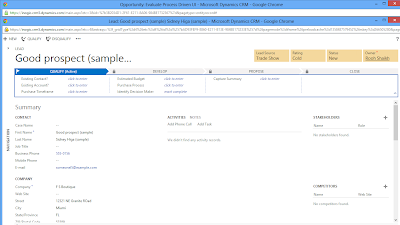A new
request called ExecuteMultipleRequest has been added to the Update
rollup 12 for the Bulk Data Load. Using this request, multiple request
can be executed with the single server call. The main advantage of this request
is that it will definitely improve the performance since in one round trip to
the server, it actually posts more than 1 message to be executed. With reduced
round trips for each individual request the performance improvement is
exponential.
ExecuteMultipleRequest
accepts the collection of different request and executes each request in a
order they appear in the collection. This request will optionally returns the
response of each request or error occurred while executing the request. Each
message request in the input collection is processed in a separate database
transaction.
Members
of ExecuteMultipleRequest:
1.
Requests: It is a collection of message
requests to execute.
2.
Settings: It contains settings that define
whether execution should continue if an error occurs executing a request and if
responses for each message request processed are to be returned.
Below
is the example, where different requests like Create/Update are added to ExecuteMultipleRequest collection and submit it for processing in a single round trip.
// Create an ExecuteMultipleRequest object.
ExecuteMultipleRequest requestWithResults = new ExecuteMultipleRequest()
{
// Assign settings that define execution behavior: continue on error, return
responses.
Settings = new ExecuteMultipleSettings()
{
ContinueOnError = true,
ReturnResponses = true
},
// Create an empty organization request collection.
Requests = new OrganizationRequestCollection()
};
//create account entity
Entity accountEntity=new Entity("account");
//set name for the account
accountEntity.Attributes["name"] = "New Account "+new DateTime();
//create CreateRequest object
CreateRequest createRequest = new CreateRequest { Target = accountEntity };
//add to ExecuteMultipleRequest Collection
requestWithResults.Requests.Add(createRequest);
//retrieve contact entity
Entity contactEntity = _service.Retrieve("contact", new Guid("FC298C3B-2E4F- E211-9DED-1CC1DE6DAA3E"),
new Microsoft.Xrm.Sdk.Query.ColumnSet());
//set Business Phone for the contact
contactEntity.Attributes["telephone1"]="1234567";
//create UpdateRequest
UpdateRequest updateRequest = new UpdateRequest { Target = contactEntity };
//add to ExecuteMultipleRequest Collection
requestWithResults.Requests.Add(updateRequest);
// Execute all the requests in the request collection using a single web method
call.
ExecuteMultipleResponse responseWithResults = (ExecuteMultipleResponse)_service.Execute(requestWithResults);
if (responseWithResults.IsFaulted)
{
// Display the results returned in the responses.
foreach (var responseItem in responseWithResults.Responses)
{
// A valid response.
if (responseItem.Response != null) { }
// An error has occurred.
if (responseItem.Fault != null) { }
}
}
Members
of ExecuteMultpleResponse:
1.
IsFaulted: It can be used to identify
if any of the messages submitted failed. Once you have identified an error you
can loop through the response item to read the error description per message
failure.
2.
Responses: Indicates the collection of
responses.
Note: This request will only work on organizations
that have UR12 applied or on Online organizations that have been upgraded to
Polaris.
For further read on this, you can also refer to Microsoft CRM SDK documentation on ExceuteMultiple here.
For further read on this, you can also refer to Microsoft CRM SDK documentation on ExceuteMultiple here.




















